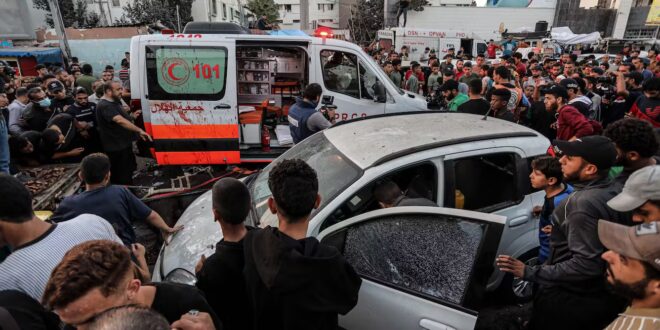The British Labour Party leader, Keir Starmer, has come under fire from members of his own party for refusing to call for a ceasefire in the Hamas-Israel war, instead pushing for a humanitarian pause in the conflict. As a result, 50 Labour councillors have quit the party. The controversy raises the question of the difference between a humanitarian pause and a ceasefire.
The conflict began in the early morning of October 7 2023 when armed Hamas fighters launched a surprise attack against Israel, killing at least 1,400 Israelis and taking more than 200 civilians hostage.
Israel responded to this attack by launching an assault on Gaza beginning with a relentless aerial bombardment and continuing now with a ground offensive. According to the Gaza health ministry, at least 10,000 people – mainly civilians – have been killed in Gaza in the month since the conflict began, including 4,100 children.
A further 25,000 people have been injured and hundreds of thousands have been displaced within the Gaza Strip, unable to leave because of the blockade imposed by Israel.
Israel’s massive bombing campaign has unsurprisingly led to a disastrous humanitarian situation. The UN secretary general, Antonio Guterres, has described the situation in Gaza as a “godawful nightmare”.
This has led the UN and other countries to pressure Israel for a “pause” in the fighting to at least provide temporary humanitarian relief to the people of Gaza.
A number of resolutions calling for a ceasefire or some form of truce have been raised in the UN security council, but on each occasion they have been vetoed by one or more of the permanent members. A non-binding resolution passed the UN general assembly on October 27, but this has been ignored by the Israeli government.
A humanitarian pause
Gaza has no access to basic humanitarian aid due to the siege and blockade that Israel has inflicted on the strip. Even before the beginning of the war, Gaza had been subject to a 16-year blockade after Hamas took political control of the strip in June 2007.
After the October 7 Hamas attack, the Israeli defence minister Yoav Gallant ordered a “complete siege” on Gaza, which included cutting off supplies of electricity, food, water and gas. These shortages have put the country’s health system at risk – hospitals are now being run on power from electric generators and with severe shortages of vital medical supplies.
According to the UN, a humanitarian pause is defined as “a temporary cessation of hostilities purely for humanitarian purposes”. It is carried out for a certain period of time and in a specific geographic location.
The pause allows civilians trapped in conflict areas to safely flee, access assistance or receive medical treatment. It also enables the passage of essential supplies such as food, fuel and medicines.
In the context of Gaza, a pause could, for example, enable civilians to flee the enclave through the Rafah crossing into Egypt. The crossing has been opened for limited periods to allow some evacuees to leave and some supplies to enter. But not enough.
There is an increasing international consensus, including from countries supporting Israel such as the US, that at least a humanitarian pause is needed.
Nonetheless, some argue that using a humanitarian pause to provide a temporary halt in the bombing of Gaza is not enough. In a report calling for a general ceasefire, Oxfam said its experience is that such pauses can even put civilians at a greater risk, as there is usually less clarity involved about safe zones and the duration of pauses.
“Rumours and misinformation spreads that this road or that ‘safe zone’ has been declared a demilitarised area, but that is often not true, leaving people walking into a warzone believing it is safe,” the report said. At the beginning of the war, routes that were thought to have been designated safe passages for evacuation from Gaza were bombed.
As a result, the only true humanitarian solution that appears ideal is a complete ceasefire.
A ceasefire: roadmap for an end to hostilities
A ceasefire is a political process rather than simply a humanitarian one. It urges parties to come together to find a political solution to the conflict.
It is meant to a be a longer-term process than a “pause” and should apply to the entire geographical area of the conflict. In this case, it would mean the whole of Gaza strip but also all others affected by the conflict such as the south of Lebanon where Israeli troops are battling with Hezbollah.
In the context of Gaza, a ceasefire would mean a complete stop of fighting on all sides, and the eventual release or exchange of hostages. It would not only mean the end of the bombardment of Gaza, but would also obligate Hamas to stop its attacks on Israel.
It is important to note that, like a pause, a ceasefire is not a permanent peace agreement. That said, the aim would be to create the conditions for a permanent settlement.
Reaching a ceasefire would likely require the involvement of a third party mediator, such as the US, Qatar or Iran.
In the previous Hamas-Israel war in 2021, both parties eventually managed to reach a ceasefire after 11 days of destruction which left more than 200 people dead. In that conflict, Egypt played a major role as a mediator.
Since the latest conflict began on October 7, the Israeli prime minister, Benjamin Netanyahu, has resisted all calls for a humanitarian pause and a ceasefire.
But the US and other allies of Israel continue to press Netanyahu for at least a pause in Israel’s assault. He insists that while “little pauses” might be arranged to allow for the exit of hostages or to facilitate the entry of humanitarian aid, a longer halt in hostilities is not possible until all hostages taken by Hamas are released. And so the killing continues
 Eurasia Press & News
Eurasia Press & News




